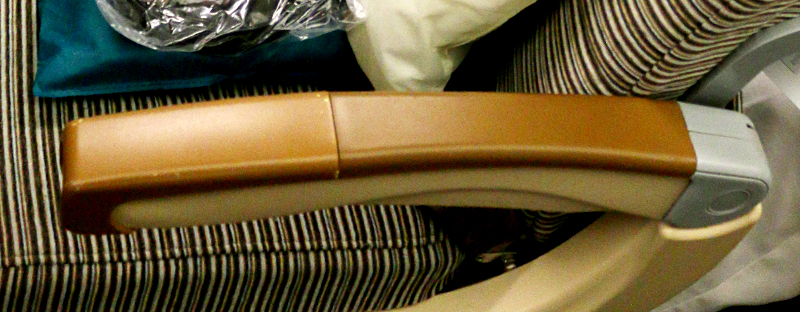I t is comical how a semi-hard slab of material narrower than the typical human arm and mounted on metal can cause so much controversy amongst frequent fliers — so much so that a boutique industry has formed with the sale of products in an attempt to alleviate the struggle between passengers aboard an airplane.
The legendary and yet dreaded armrest — found between seats in the economy class cabin of commercial aircraft — must have been designed by some sadist who relished the thought of stirring up trouble aboard airplanes while in flight. Despite other advances in aircraft technology — in-flight entertainment systems, improved ventilation, different materials for seats are only a few examples — the lowly armrest has remained basically unchanged over at least forty years of commercial aviation…
…not counting the removal of that little metal indentation — equipped with a door that flipped open — which once served as a pathetic ash tray when cigarette smoking was still allowed during flights.
The armrest feels hard on the elbow — exert enough pressure to feel it give a little, unless it is constructed of rigid plastic — and it can potentially cause discomfort and even pain if used for an extended period of time.
The Controversial Armrest Wars
It amazes me that such a small yet benign piece of solid state equipment — hey, I am attempting to be euphemistic here — is designed to serve two people when it can barely adequately serve one person. This anomaly of poor design has caused in and of itself a significant amount of controversy on FlyerTalk — most notably, pertaining to etiquette. In fact, passengers can become territorial to the point where they fight over that arguably useless piece of equipment.
Fighting over an armrest? Are they serious?!?
To be fair, creative thinkers have attempted to resolve the armrest issue. One design by a management trainee for Cathay Pacific Airways conceptualized an armrest resembling a paper clip. The design is simple yet rather clever, and it could potentially mitigate the struggle between two passengers as to who gets to use the armrest; but a new struggle could occur over who gets to use the upper part of the armrest versus who gets to use the lower part — and that lower part may not work for passengers with long arms…
…and then, there is the portable armrest. Yes, that’s right, folks — for only sixteen dollars plus five dollars for shipping, you too can support both of your elbows in comfort with a design which resembles a miniature version of a straightjacket. This product must not be selling too well — it was reduced from its original price of twenty dollars, and I have not seen much mention about it on FlyerTalk. This baby will look real good on you along with that pillow doughnut something worn around your neck as you wear those eye shades from that amenity kit you received on your transpacific flight seven years ago.
Some egregious passengers selfishly and erroneously use the armrests on the row of seats in front of them as their own personal footrests. Ahh, yes — there is nothing more soothing that to smell that odor resembling the faint essence of rotting cheese wafting only inches below your nose to send your olfactory senses into a whirlwind of torture to help trigger that nausea in the pit of your stomach at full throttle. There is nothing more comforting than the knowledge that that bare foot had the pleasure of bathing itself in the errant stagnant puddles of urine on the floor of the lavatory in the rear of the aircraft before finding your arm with which to caress — complete with wiggling toes and the sandpaper-like texture of the callouses of the sole from the callous soul. FlyerTalk members offer advice on the best way to remove the foot of the thoughtless oaf seated behind you from your armrest.
In many cases, the armrest has another function: to act as a separator between seats. Except for armrests on many aircraft located adjacent to the aisle or in an exit row, you can lift the armrest up and out of the way, creating a more spacious environment — if there is not another passenger seated next to you…
…and if you are unfortunate enough to sit next to a passenger who must raise those armrests because he or she cannot help but exceed the physical boundaries of his or her seat and encroach upon your allotted space due to his or her size — well — that discussion is for another day.
Besides, who gets to decide whether or not the armrest remains down or it is lifted up? I prefer it down so that my space is clearly defined. I am not sure that a passenger who has his or her headphones plugged into the jack in the armrest would appreciate it if it was lifted up — but then again, that would probably be less of a problem today than when passengers used to have to listen to audio sounds through a conveyance that was nothing more than a cheap hollow double plastic tube with little sponges that you stuffed into your ears. It was like listening to the adults speak in Charlie Brown cartoons, with their muffled gibberish. I could not understand a word anyone was saying — especially when the tubes had a kink in them. Those “headphones” were probably designed by the same sadist who devised the modern armrest. Thank goodness those hollow tubes are gone.
If you are lucky enough to sit in a bulkhead seat, you get to have the stationary armrests equipped with the tray tables built in. Opening up that armrest to take out the tray table can sometimes be an exercise in frustration, as it can be like a groundhog not wanting to come out of its hole in the ground — no matter how much you attempt to coax it. Of course, that is assuming that the passenger seated next to you does not have his or her arm firmly planted on the armrest containing your tray table just as hunger overtakes you, or you feel that need to work on your laptop computer. Sure, there is no passenger in front of you to recline his or her seat — but combined with the limited leg room in many cases, I usually avoid bulkhead seats for these reasons.
Summary
I tend to adhere to the opinion that the person seated in the middle seat should have full and complete use of both armrests. That person already has no access to the aisle, where he or she can freely escape the confines of that economy class seat; nor access to the window to partake in the view — or, at least have an extra place to rest his or her head. Besides, the person in the middle seat is sandwiched between two people — unlike passengers seated in an aisle seat or window seat, who only have one passenger with which to contend. Giving the use of both armrests to that poor person stuck in the middle seat can be some sort of consolation — as minimal as it may be.
Fortunately, when I do use the armrest, I usually do not need the entire armrest — I will usually just rest my elbow. When seated next to a passenger with a similar requirement, it is a simple matter of subconsciously jockeying for position until both of us are satisfied with the simultaneous use of the armrest. Either my elbow will be in front of the elbow of my seatmate, or it will be behind it. This usually works out most of the time without a single word being said.
The armrest wars — as with the debate pertaining to reclining seats — are yet another factor of many which can potentially inhibit the attempt to enjoy reasonable comfort when you are a passenger in the economy class cabin in an airplane. Perhaps if airlines charged significantly higher airfares to the point where it is as though they “cost you an arm and a leg”, that could resolve the heated disputes over armrests due to — well — fewer arms and legs, of course.
So, who gets the armrest? What is your opinion? What are your experiences?
Photograph ©2015 by Brian Cohen.

